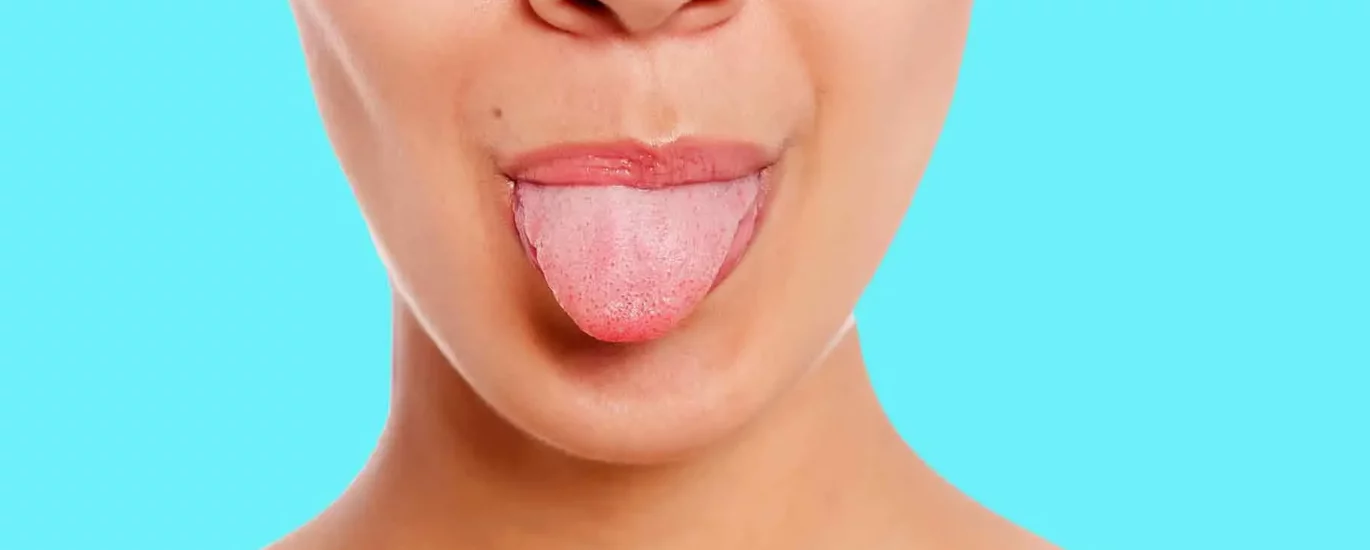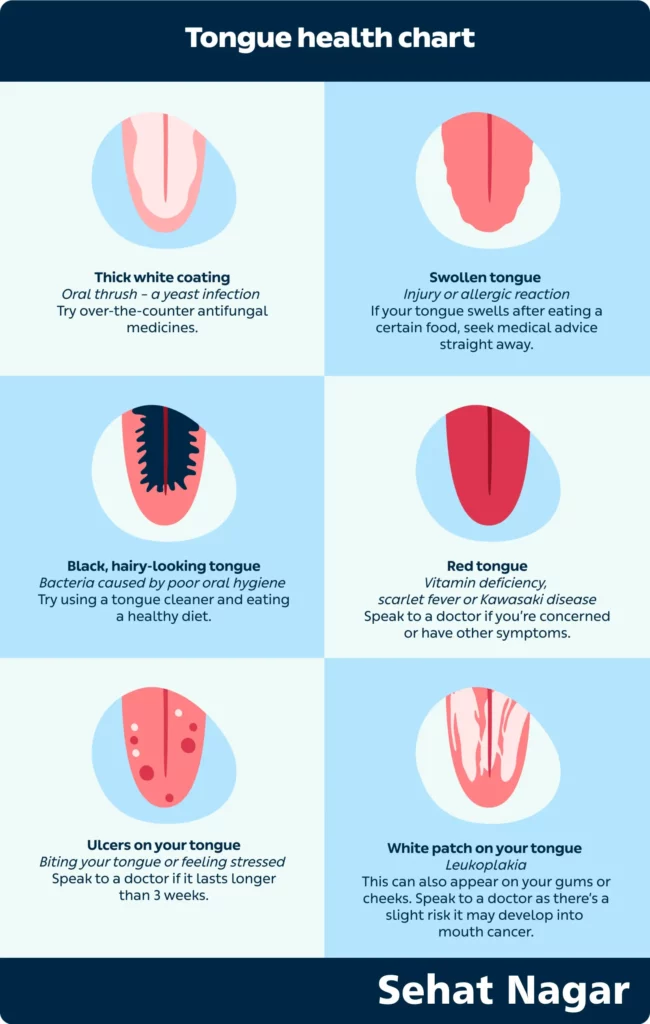


Did you know that our tongues are not only for tasting delicious food but also for keeping us healthy? Our tongues play an important role in our overall well-being, and it is important for us to take care of them. To help us keep track of our tongue’s health, there is a special tool called a “tongue health chart.” A tongue health chart is like a picture guide that helps us see if our tongues are healthy or if there are facing any problem. Normally, a healthy tongue looks pink, wet, and doesn’t have anything strange on it. But sometimes, our tongues can change color or have a coating, bumps, or sores, which might mean something is not right.
Using a tongue health chart is like playing a matching game. We look at our tongue and compare it to the pictures on the chart. If we see something different on our tongue that matches a picture on the chart, it tells us that we might need to talk to a dentist or doctor about it. Remember, the tongue health chart doesn’t replace going to the dentist or doctor, but it helps us keep an eye on our tongues and talk to them about any changes we notice. It is a way for us to be responsible for our own health and take action if needed.
By using a tongue health chart, we can learn more about our tongues and how to keep them healthy. It is like having a secret detective tool to solve tongue mysteries and make sure we’re taking care of ourselves. So, let’s explore more about tongues, learn how to read tongue health chart, and discover tips for keeping our tongues healthy!
The tongue is an awesome part of our body that helps us do many things. It is not just a squishy thing in our mouths; it has a special structure and does important jobs. Our tongues have muscles that let us move them around. We use our tongues to talk, eat, and even make silly faces. But that’s not all! Have you ever wondered how we can taste yummy flavors? Well, that’s because of our taste buds, little taste detectors on our tongues. Taste buds are like tiny superheroes that can sense different flavors. They can taste sweet, sour, salty, and bitter things. When we eat something, the taste buds send messages to our brain, telling us what it tastes like. That’s why we know if something is delicious or yucky!
Now, just like we wash our hands to keep them clean, we need to keep our tongues clean too. If we don’t, yucky stuff can stick to our tongues, like germs and food pieces. That can make our breath smell bad and even cause cavities. To keep our tongues clean, we should brush our teeth two times a day and also gently brush our tongues. You can use a soft toothbrush or a special tongue cleaner tool. By doing this, we can get rid of the icky stuff and keep our mouths fresh and healthy.
Remember, it’s not just about cleaning our tongues. We also need to pay attention to any changes or problems. Sometimes our tongues might look white, which could mean something is not right. If we see anything strange or our tongues hurt, it’s important to tell a grown-up or go to the dentist.
Sometimes our tongues can have a white coating on them, which means something might not be right. This can happen when there are leftover food or germs on our tongues. It can also be a sign of an infection called oral thrush, caused by a fungus called Candida.
To prevent a white coating, we need to take care of our mouths. Brushing our teeth and cleaning our tongues gently can remove the bacteria and food that cause it. But if the white coating doesn’t go away or keeps coming back, we should tell a grown-up or go to the dentist. It might mean there is a health problem we need help with.
If our tongues look red or swollen, it means they are irritated or bigger than usual. This can happen because of allergies or not getting enough vitamins like vitamin B12 or iron. Some medications or mouthwashes can also change the color of our tongues and make them red.
Usually, a red or inflamed tongue doesn’t need urgent help. We can try avoiding things that make it worse and eating healthy foods. But if the redness or swelling doesn’t go away, hurts a lot, or we have other problems too, we should tell a grown-up or a doctor. They can tell us if we need more help.
Don’t worry, our tongues don’t grow real hair! But sometimes they can look black or dark and have long bumps. This is called a black hairy tongue. It happens when too many bacteria or yeast grow in our mouths. Not cleaning our mouths well, smoking, taking certain medicines, or using strong mouthwashes can cause it.
To keep our tongues healthy, we need to clean our mouths properly. That means brushing our teeth and gently cleaning our tongues. By getting rid of bacteria, we can avoid a black hairy tongue. If our tongue turns black or we are worried about it, we should tell a grown-up or a dentist. They can help us with advice or treatment.
Sometimes, we can get bumps or sores on our tongues, and they can be painful. There are different kinds of bumps and sores, like canker sores, oral thrush, or oral herpes. Canker sores are small ulcers that hurt. Oral thrush is a fungal infection that makes white patches on the tongue. Oral herpes causes painful blisters.
If we see any bumps or sores on our tongues that don’t go away in a week or hurt a lot, we should tell a grown-up or see a doctor. They can tell us what’s wrong and how to make it better. It’s always good to ask for help if we are worried about bumps or sores on our tongues.
Remember, we can prevent many tongue problems by taking care of our mouths and asking grown-ups or doctors for help when needed. By keeping our tongues healthy, we can enjoy all the tasty things in life!
A tongue health chart is a cool tool that can help us take care of our tongues. It’s like a special guide that shows us how our tongues should look and helps us notice any changes. Using a tongue health chart has lots of benefits and can teach us about our oral health. The purpose of a tongue health chart is to help us check how our tongues look and find out if anything is different. It has pictures and descriptions that show us what a healthy tongue should look like. We can compare our own tongue to the chart and see if there are any changes, like a white coating, redness, bumps, or sores.
The tongue health chart has different sections that show different tongue conditions and colors. For example, there’s a section for a healthy tongue, which is usually pink and looks nice. Then there are sections for a white-coated tongue, a red or swollen tongue, or even a black hairy tongue. Each section also helps us understand what different tongue problems might look like. Using the tongue health chart is easy! We just need to look at our own tongue in a mirror and compare it to the pictures on the chart.

We can use a notebook or a piece of paper to record the date and any changes we notice in our tongues. This way, we can keep a record of any changes that happen over time. Keeping track of our tongue changes using the chart is important because it helps us know more about our oral health. If we see any changes that don’t go away, it is important to tell a dentist.
So let’s get our tongue health chart, and start taking care of our tongues in a super cool way!
Understanding the tongue health chart is super important! It helps us figure out what’s going on with our tongues. But remember, if we see anything strange, it’s best to talk to a doctor or dentist for help.
The color of our tongues can tell us a lot. A healthy tongue is usually pink, like a bubblegum. But if our tongue looks white, it might mean there are germs or an infection. A red or swollen tongue could be because of allergies or not getting enough vitamins. And if our tongue looks black or dark, it might be a condition called black hairy tongue. If our tongue doesn’t match the healthy color on the chart, it’s important to ask a grown-up or a doctor.
Sometimes our tongues can have a thin layer on top called a coating. It’s usually okay if it’s a little white from food. But if the coating is thick, patchy, or a strange color, it could be a sign of a problem. A white coating might mean we have oral thrush, and a yellow coating might mean a bacterial infection. However, paying attention to the coating on our tongues helps us understand what’s going on.
The chart also helps us notice any bumps or sores on our tongues. Small bumps are usually nothing to worry about, but big or long-lasting bumps might need a closer look. Sometimes we get canker sores, which go away on their own. But other sores might mean we have an infection or something more serious. If we see any strange bumps or sores, it’s important to tell a grown-up or see a doctor.
Remember, the tongue health chart is a good starting point, but it’s not the final answer. If we’re worried or see big changes in our tongues, we should talk to a doctor or dentist. They can tell us what’s going on and help us get better if we need it.
By using the tongue health chart and asking for help when we need it, we can keep our tongues healthy and happy!
Read Also: Kill Tooth Pain Nerve In 3 Seconds Permanently
To maintain a healthy tongue, remember these tips: brush and floss your tongue along with your teeth, drink plenty of water, eat healthy foods, avoid tobacco, limit sugary treats, try a tongue scraper, and visit the dentist regularly. By following these tips, you can keep your tongue strong and clean, and have a happy smile!
Keeping our tongues healthy is super important! The tongue health chart helps us understand our tongues better and spot any problems. By using the chart and talking to a doctor or dentist when we see something strange, we can take good care of our tongues. Remember to follow the tips for maintaining a healthy tongue, like brushing and flossing, drinking water, eating healthy foods, avoiding tobacco, using a tongue scraper, and also visiting the dentist. Let’s keep our tongues happy and have a great smile!
Read Also:
Where To Inject Botox For Lip Flip?